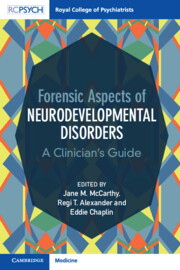Book contents
- Forensic Aspects of Neurodevelopmental Disorders
- Forensic Aspects of Neurodevelopmental Disorders
- Copyright page
- About the Cover Page
- Contents
- Contributors
- Foreword by the Rt Hon Lord Bradley
- Terminology Used in the Book
- Section 1 An Overview: Definitions, Epidemiology and Policy Issues
- Section 2 Assessment and Therapeutic Approach
- Chapter 11 Attention Deficit Hyperactivity Disorder: Assessment and Therapeutic Approaches within Forensic Settings
- Chapter 12 Autism Spectrum Disorder: Assessment and Therapeutic Approaches within Forensic Settings
- Chapter 13 Intellectual Disability: Assessment and Therapeutic Approaches within Forensic Settings
- Chapter 14 Risk Assessments in People with Neurodevelopmental Disorders
- Chapter 15 Assessment and Treatment of Young Offenders
- Section 3 Criminal Justice Pathways and Legal Issues
- Index
- References
Chapter 14 - Risk Assessments in People with Neurodevelopmental Disorders
from Section 2 - Assessment and Therapeutic Approach
Published online by Cambridge University Press: 18 May 2023
- Forensic Aspects of Neurodevelopmental Disorders
- Forensic Aspects of Neurodevelopmental Disorders
- Copyright page
- About the Cover Page
- Contents
- Contributors
- Foreword by the Rt Hon Lord Bradley
- Terminology Used in the Book
- Section 1 An Overview: Definitions, Epidemiology and Policy Issues
- Section 2 Assessment and Therapeutic Approach
- Chapter 11 Attention Deficit Hyperactivity Disorder: Assessment and Therapeutic Approaches within Forensic Settings
- Chapter 12 Autism Spectrum Disorder: Assessment and Therapeutic Approaches within Forensic Settings
- Chapter 13 Intellectual Disability: Assessment and Therapeutic Approaches within Forensic Settings
- Chapter 14 Risk Assessments in People with Neurodevelopmental Disorders
- Chapter 15 Assessment and Treatment of Young Offenders
- Section 3 Criminal Justice Pathways and Legal Issues
- Index
- References
Summary
There has been debate as to how the presence of neurodevelopmental conditions such as intellectual disability (ID), autism spectrum disorder (ASD) or attention deficit hyperactivity disorder (ADHD) relate to risk of violence or sexual behaviour causing harm to others. Further debate has centered on whether mainstream structured professional judgement risk assessments have face, content and predictive validity in populations with these conditions. Some have argued for attaining a structured assessment of risk, which is specific to each of these conditions. However, the broad range of presentations and comorbidity of these disorders both with each other, and with other mental disorders (such as psychosis and personality disorders) are likely to make that goal unattainable and, arguably, undesirable. Successful approaches are those which contextualise structured professional judgment risk assessment in relation to the neurodevelopmental disorder, preferably utilising existing supplementary guidance to mainstream risk assessments. A focus on risk formulation, with careful attention paid to the function of the behaviour in the context of the neurodevelopmental condition, is advocated.
Keywords
- Type
- Chapter
- Information
- Forensic Aspects of Neurodevelopmental DisordersA Clinician's Guide, pp. 164 - 178Publisher: Cambridge University PressPrint publication year: 2023



